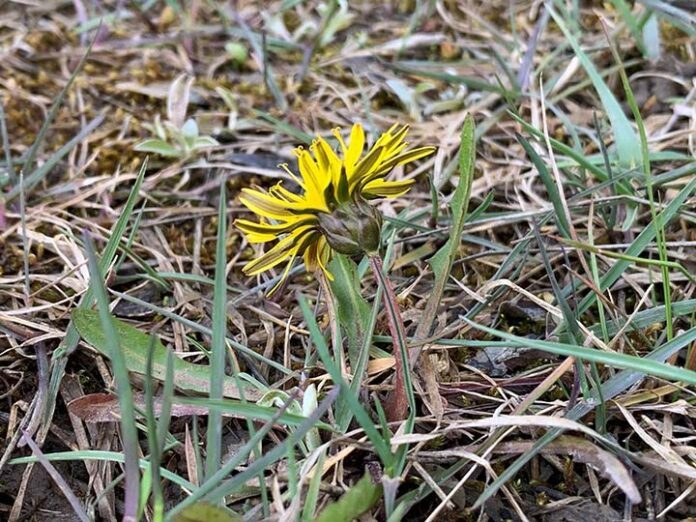Fred Schueler, Fragile Inheritance Natural History
There are a number of native Dandelions in northern North America, but in Ontario, south of some islands in Lake Superior, all our Dandelions, genus Taraxacum, are introduced from Europe, and at times in the spring they are our most conspicuous alien species. Dandelions mostly don’t reproduce sexually, but produce seeds asexually by apomixis, without pollination, resulting in offspring that are genetically identical to the parent plant. This means that species limits are arbitrary, and the Flora of North America gives the number of species in the genus at something between 60 and 2000, which may be a world-record level of disagreement. Clones, or “microspecies” which have adaptive characteristics can take over uniform habitats: those that hug the ground dominate lawns, while those that reach upwards with big leaves are found in woodsy places. Since they don’t require pollination, selection among clones may favour those with reduced nectar and pollen production, explaining their relative unattractiveness to pollinators.
Back in the day, the only difference noticed among southern Ontario Dandelions, by those who didn’t do microspecies, was between the otherwise nearly identical Common (T. officinale) and Red-seeded (T. erythrospermum) plants, but in 1989 Ottawa botanist Dan Brunton published an account of Dandelions, in a different section of the genus, T. palustre, the Marsh, Fen, or Oldfield Dandelion, that he’d found in eastern Ontario and northern New York. This species was conspicuously different from the ordinary T. officinale in the shape of the flowerheads, because instead of folding back from the bloom, the bracts, or phyllaries, clasp the base of the flowerhead in a dark bulge. Also the leaves are quite thin, and are nowhere near as toothed as in our other Dandelions, and many of the plants are small. “Palustre” means marshy, and while along a grassy roadside they’re the ones down near the water level in the flooded portion of the ditch, they’re especially abundant in shallow-soil old-field limestone barrens, where conditions alternate between soggy and parched.
Botanists are often accused of getting excited about insignificant matters, and the point of bringing these Dandelions to public notice is that they are among our earliest-flowering plants, and the palustre bloom a few days before the officinale, so they may be the first blooms you see in a spring. After a while you can pretty well recognize the T. palustre from above by their less-toothed leaves and subtle differences in the flowerhead, and you can then stoop down, see the dark round base of the bloom, welcome a new species to the landscape, and be a bit glad that it was first recognized by an eastern Ontario botanist.
And yes, Virginia, all parts of all Dandelions are edible and delicious, and you can read about how we prepare them at https://adaptating.blogspot.com/2019/05/the-dandelion-diet.html (by the way, you can now read that ordinary Dandelions having red seeds is a repeatedly occurring mutation, so the old distinction of red- and brown-seeded species may have been spurious).






